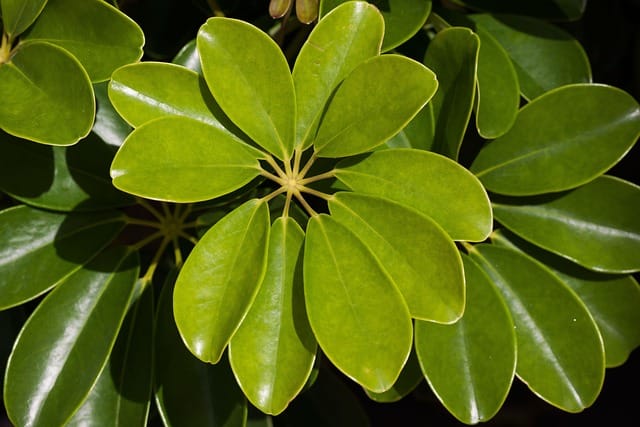How to grow Schefflera Plants
Welcome to the comprehensive guide on growing Schefflera plants as indoor plants

In this article:
- Introduction
- Overview of Schefflera Plants
- Choosing the Right Schefflera Variety
- Indoor Growing Conditions
- Lighting Requirements
- Temperature and Humidity Needs
- Watering and Fertilizing
- Potting and Soil Requirements
- Pruning and Training
- Controlling Pests and Diseases
- Repotting Schefflera Plants
- Propagation Methods
- Common Problems and Troubleshooting
- Schefflera Plant Care Calendar
- Conclusion and Final Tips
Introduction
Welcome to the comprehensive guide on growing Schefflera plants as indoor plants. In this article, you will learn everything you need to know about caring for Schefflera plants to ensure healthy growth and vibrant foliage.
Overview of Schefflera Plants
Schefflera plants, also known as umbrella plants, are tropical evergreen shrubs or small trees that have become popular houseplants due to their attractive foliage and easy maintenance. They are native to regions like Australia, New Guinea, and the Pacific Islands.
Choosing the Right Schefflera Variety
There are several Schefflera varieties available, each with its own unique characteristics. When selecting a Schefflera plant for indoor cultivation, consider factors such as size, leaf color, and growth habit to find the variety that best fits your space and preferences.
Indoor Growing Conditions
Schefflera plants thrive in conditions that mimic their natural tropical habitat. Providing the right temperature, humidity, and airflow is crucial for their healthy growth. Place your Schefflera plant in a well-ventilated room away from drafts and extreme temperature fluctuations.
Lighting Requirements
Proper lighting is essential for Schefflera plants. They prefer bright, indirect light but can tolerate moderate shade. Placing your plant near a north or east-facing window is ideal. If natural light is limited, you can supplement it with artificial grow lights to ensure adequate light intensity.
Temperature and Humidity Needs
Consistent temperatures between 60-75°F (15-24°C) are ideal for Schefflera plants. They can tolerate slightly cooler temperatures but are sensitive to cold drafts. Maintain a humidity level of 40-60% by misting the leaves regularly or using a humidifier.
Watering and Fertilizing
Proper watering and fertilization are crucial for the health of Schefflera plants. Water them thoroughly when the top inch of soil feels dry, but be careful not to overwater as it can lead to root rot. Fertilize with a balanced houseplant fertilizer every 4-6 weeks during the growing season.
Potting and Soil Requirements
Choose a well-draining potting mix that retains moisture without becoming waterlogged. Repot your Schefflera plant every 1-2 years, or when it outgrows its current pot. Ensure the new pot has proper drainage holes to prevent waterlogging.
Pruning and Training
Regular pruning helps maintain a compact and bushy growth habit for Schefflera plants. Remove any yellowing or damaged leaves, and trim back leggy growth to encourage branching. Training can also be done using stakes or trellises to support the plant and create a desired shape.
Controlling Pests and Diseases
Monitor your Schefflera plant for common pests like spider mites, aphids, and mealybugs. Regularly inspect the leaves and stems for signs of infestation, and treat with organic insecticidal soap or neem oil if necessary. Proper hygiene, good airflow, and avoiding overwatering can help prevent fungal diseases.
Repotting Schefflera Plants
As your Schefflera plant grows, it will eventually need repotting to provide adequate space for its roots. Repotting is best done in spring or early summer when the plant is actively growing. Carefully lift the plant from its current pot and transplant it into a slightly larger container with fresh potting soil.
Propagation Methods
Schefflera plants can be propagated through stem cuttings or air layering. Both methods have a high success rate and allow you to create new plants. Whether you choose to propagate in water or directly in soil, ensure the cuttings or layered stem are kept in a warm and humid environment until roots develop.
Common Problems and Troubleshooting
Yellowing leaves, leaf drop, and browning tips are common issues with Schefflera plants. These problems can be caused by overwatering, underwatering, improper lighting, or poor air circulation. By understanding the potential causes and making appropriate adjustments, you can troubleshoot and resolve these issues.
Schefflera Plant Care Calendar
Providing a care calendar for your Schefflera plant helps you stay on track with its specific needs throughout the year. From watering and fertilizing to pruning and repotting, having a schedule ensures your plant remains healthy and thrives.
Conclusion and Final Tips
Growing Schefflera plants indoors can be a rewarding experience. By understanding their growth requirements and providing the right care, you can enjoy their lush foliage and tropical vibes in your own home. Remember to observe your plant closely, adjust care as needed, and enjoy the beauty of your thriving Schefflera plant.
